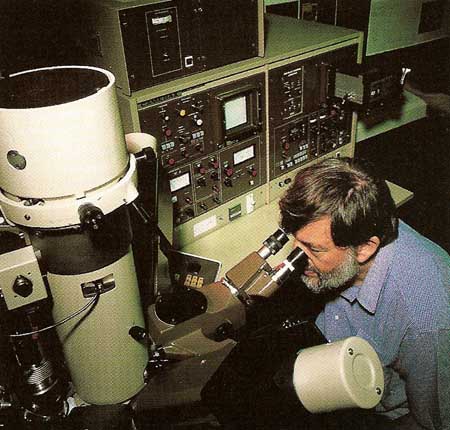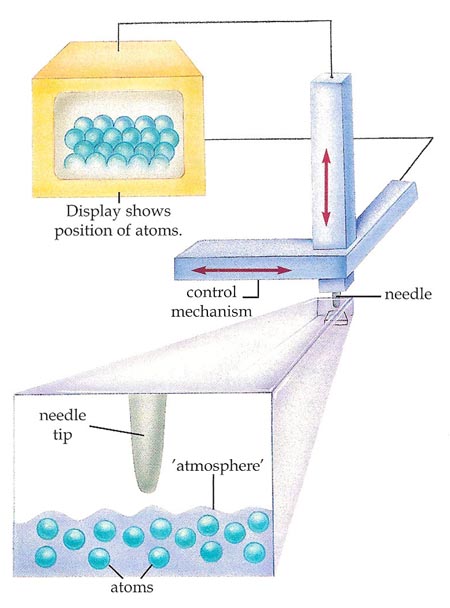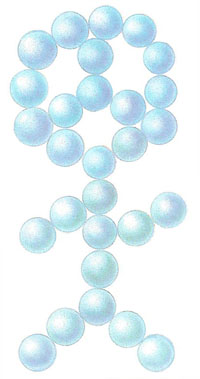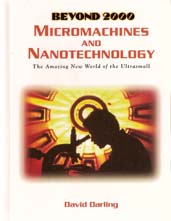MICROMACHINES AND NANOTECHNOLOGY: The Amazing New World of the Ultrasmall - 5. The Atomic Erector Set

Figure 1. A scientist uses an electron microscope to magnify objects up to 40,000 times.

Figure 2. How a scanning-tunneling microscope works.
Nature manages to put structures like crystals together one atom or molecule at a time. But how can human beings work with building blocks that are this small? Until recently, the very idea would have seemed incredible. But within the past few years, scientists have developed means to pick up individual atoms and move them around with great precision. By applying this new skill, they can draw pictures or write words by placing atoms exactly where they want them.
Seeing the Very Small
Before you can build with individual atoms, you have to be able to see where they are. Ordinary microscopes, like those you may have used at school or at home, are known as optical microscopes because they work with visible light. They are ideal for studying objects the size of, say, small pond creatures or crystals of salt and sugar. But a microscope that uses visible light cannot possibly show anything as minute as an atom or molecule.
A microscope is limited by the wavelength of the radiation that it employs. The wavelength is just the distance between the crest of one wave and the crest of the next. Visible light has a wavelength of between 400-thousandths and 700-thousandths of a centimeter. Short though that may seem, it means that the smallest object an optical microscope can reveal is still many times larger than an atom.
In the 1930s, scientists developed a much more powerful instrument called the electron microscope (see Figure 1). As with all of the smallest particles in nature, electrons can behave both like tiny bullets of matter and like waves. Electron waves are much shorter than light waves so that electron microscopes can detect more detail in whatever is being examined. However, even an electron microscope cannot give a clear view of objects the size of atoms.
Supermicroscopes
To see individual atoms, scientists needed a completely new type of microscope. The first of these superpowerful instruments was built in 1981; it is called the scanning-tunneling microscope (see Figure 2).
All solid objects are covered with an incredibly fine cloud of electrons. This cloud is thickest and rises farther from the object's surface wherever there is an atom, just as real clouds tend to hang around mountaintops. Using a scanning-tunneling microscope, a researcher can map the electron cloud on a tiny patch of a surface and so find out exactly where the atoms below are located.
The most important part of a scanning-tunneling microscope is its needle, or probe, made from the metal tungsten. This needle is made very sharp by various chemical and electrical processes. At its tip, it is so sharp that there is just a single atom or very small cluster of atoms sticking out above the rest.
This ultrafine needle is moved slowly, back and forth, across the surface being examined, advancing by less than a nanometer after each sweep. Although the needle never actually touches the surface, it comes so close that the electron cloud covering the surface and the electron cloud surrounding the tip of the needle overlap. A minute voltage is applied to the needle. This allows electrons to hop from the surface to the needle, a movement that results in a tiny current of electricity. By just the right amounts to keep this current the same, a sensitive control system raises and lowers the needle as it moves along.
The up-and-down movements of the needle are turned into a picture on a television screen that shows where each individual atom or molecule on the surface is located. Roughly speaking, a "mountain" on the picture corresponds to an atom, a "valley," to where there is no atom.
Putting Atoms in Their Place
 |
| CO Man was made from 28 molecules of carbon
dioxide and measures just 5 millionths of a millimeter from head to
toe
|
Scientists realized that the scanning-tunneling microscope could do more than just atoms. It could also be used to pick them up and move them around.
Normally the voltage on the tip of the microscope's needle is kept very low, to avoid disturbing the atoms on the surface. But if the voltage is increased when the needle is placed exactly over an atom, then that atom can be made to stick to the needle tip. In 1990 two scientists at the computer company IBM used this technique to write their company's name one atom at a time.
The IBM researchers began by spraying atoms of the gas xenon onto a clean nickel surface that had been cooled to minus 269 degree Celsius (minus 452 degrees Fahrenheit). At this very low temperature, the atoms remained very still. Using a scanning-tunneling microscope, the researchers found out exactly where the xenon atoms had landed on the surface. Then they put the needle over one of the xenon atoms, increased the voltage on the needle on the needle so that the atom stuck to the tip, and slid the atom across the nickel surface to the exact position they wanted it. When the atom was in place, the researchers dropped the voltage so that the atom was released. They repeated this process until 35 xenon atoms spelled out the letters IBM.
A year later the same team created CO Man. This was a picture of a little man made from 28 molecules of the gas carbon monoxide (which has the chemical formula CO).
Writing words and drawing pictures with atoms and molecules may seem like a waste of time. But the ability to place individual atoms and molecules precisely may prove to be very important in the future. Using this technique, scientists might build, atom by atom, custom-designed molecules with special properties. Other possibilities include the creation of atomic-scale data storage, so that, for instance, you might someday be able to hold all the information in all the world's libraries in the palm of your hand. In fact, comical creations like CO Man really mark the birth of nanotechnology.
| Reading the Small Print
It is surprising how tiny some people have been able to write even without the aid of advanced scientific instruments like the scanning-tunneling microscope. In 1926 a man used a diamond point connected to a mechanical device called a pantograph to put the Lord's Prayer onto an area of glass measuring just 0.04 millimeter (0.0016 inch) by 0.02 millimeter (0.0008 inch). In 1983 Tsutamu Ishii of Tokyo managed to write the names of 184 countries on a single grain of rise and the words Tokyo Japan in Japanese on a human hair! |

